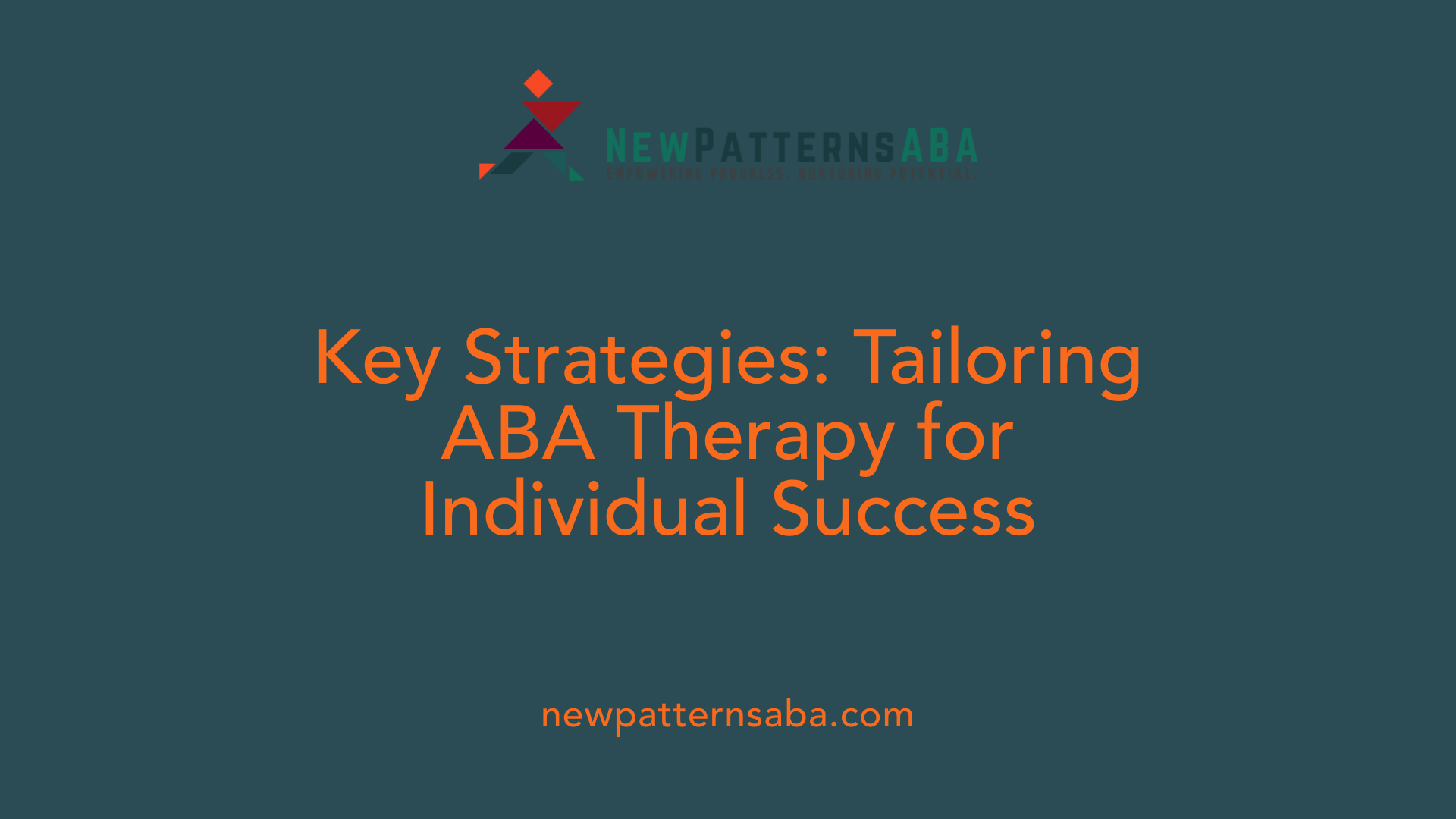Unleashing Potential: Building Independence Through ABA Therapy
Understanding ABA Therapy
Applied Behavior Analysis (ABA) Therapy is a transformative approach that empowers children with autism to develop essential skills needed for independence. Through structured learning and reinforcement techniques, this therapy aids in transforming lives by focusing on communication, social interaction, and life skills essential for daily living. As families look for effective strategies to support their children, ABA emerges as a powerful tool that not only enhances immediate functioning but also lays the groundwork for long-term success.
ABA Therapy: A Pathway to Independence for Children with Autism

How does ABA therapy help promote independence in children with autism?
ABA therapy serves as a comprehensive approach to fostering independence in children with autism. It focuses on teaching essential life skills like personal hygiene, dressing, and household chores, which are critical for daily living.
Children learn these skills in a structured environment where tasks like getting dressed are broken down into manageable steps. This method allows them to practice and master each component thoroughly, facilitating gradual autonomy.
Use of reinforcement and visual aids
A core element of ABA therapy is positive reinforcement, which encourages children to repeat desired behaviors. When they successfully perform a task independently, they receive rewards, reinforcing their motivation to learn. Additionally, visual aids such as checklists and instructional cards are employed to help children manage their daily routines more effectively. This combination fosters an environment where self-sufficiency can thrive.
Family and community involvement
Family education is a vital aspect of ABA therapy. Caregivers are equipped with strategies to support their child's learning at home, enhancing consistency and nurturing independence.
Community engagement is also emphasized, with children introduced to local resources and programs. This approach not only prepares them for adulthood but also enriches their social interactions. As they navigate social environments and engage with peers, their confidence grows, laying the groundwork for greater self-sufficiency as they transition into adult life.
The Multifaceted Benefits of ABA Therapy

What are the benefits of ABA therapy in developing various skills for individuals with autism?
ABA therapy provides a broad spectrum of benefits for children on the autism spectrum. By concentrating on enhancing communication, social skills, and daily living capabilities, it fosters significant growth in their ability to function independently.
Here's how ABA therapy supports skill enhancement:
- Communication skills improve as children learn to express their needs both verbally and nonverbally. This reduces frustration and enhances interactions, aiding them in navigating daily situations at home and in school.
- Social skills are a major focus. Children learn essential techniques such as taking turns, sharing, and initiating friendships, which are important for forming connections with peers and caregivers.
- Daily living skills such as dressing, personal hygiene, and household tasks are taught through structured steps, empowering children to manage these activities with increased independence.
How does ABA therapy develop communication and social skills?
ABA therapy employs positive reinforcement to encourage children to practice their new skills, promoting consistency and reducing behavioral challenges. Throughout therapy, children practice critical communication strategies:
- They learn to identify and articulate their needs, leading to better understanding in their relationships.
- Group activities often become easier as children gain the requisite social skills, fostering confidence in social settings.
What effects does early intervention have with ABA therapy?
Research emphasizes that early intervention through ABA therapy can lead to profound positive outcomes. Children who start therapy at a young age often experience greater improvements in:
- Functional communication skills, which can close the gap between their capabilities and those of their neurotypical peers.
- Behavioral adaptability, which prepares them for greater autonomy.
- Overall skill development, increasing their abilities in areas like money management and vocational skills, vital for future independence.
Here’s a helpful table summarizing the key areas of focus in ABA therapy:
| Skill Area | Benefits | Example Activities |
|---|---|---|
| Communication Skills | Reduces frustration and improves interactions | Teaching expressive language and requests |
| Social Skills | Enhances peer relationships and group participation | Engaging in turn-taking games |
| Daily Living Skills | Promotes independence in personal care and chores | Learning to dress and manage hygiene |
| Executive Functioning Skills | Improves planning and problem-solving abilities | Time management tasks |
| Community Engagement | Fosters confidence in navigating public spaces | Using public transport and community outings |
In summary, ABA therapy is a tailored approach that equips children with essential skills, supporting their journey toward independence and self-sufficiency.
Social Skill Enhancement through ABA Therapy

How does ABA therapy improve social skills in children with autism?
ABA therapy improves social skills in children with autism by systematically breaking down complex social interactions into smaller, manageable components.
This structured approach empowers therapists to create individualized programs that target specific skills such as:
- Eye contact
- Turn-taking
- Initiating conversations
Children get the opportunity to practice these skills in a controlled environment, which helps them gain confidence and comfort in social situations. Alongside this, positive reinforcement plays a crucial role. By rewarding desirable behaviors, therapists encourage children to repeat those socially appropriate actions.
Positive Reinforcement in Social Skill Development
Positive reinforcement is a core element in the success of ABA therapy. It enhances the likelihood that children will engage in positive social behaviors repeatedly. For instance, when a child successfully shares a toy or makes eye contact during a conversation, they receive praise or a small reward. This not only solidifies their learning but also makes the process enjoyable, reinforcing a desire to engage positively with peers.
Generalization of Skills into Everyday Interactions
Over time, the strategies learned in therapy lead to the generalization of social skills into real-life interactions. This means that children begin to apply what they've practiced in structured settings to casual situations with peers, family, or during community engagements. Through consistent practice and encouragement, children become more adept at navigating different social scenarios, resulting in improved social interactions and fostering friendships.
Core Strategies in ABA Therapy

What methodologies and strategies are used in ABA therapy?
ABA therapy employs a variety of methodologies and strategies designed to improve specific behaviors and skills. Here's a breakdown of some core strategies:
Positive Reinforcement: This is a fundamental element that encourages desired behaviors by providing rewards. When a child engages in recognized positive behavior, they receive praise or tangible rewards, motivating them to repeat those behaviors.
Negative Reinforcement: This involves the removal of undesirable stimuli following appropriate behavior, promoting future compliance without the negative influence.
Discrete Trial Training (DTT): This method breaks down skills into small, manageable tasks. Each task is taught as a discrete trial, which allows children to focus on specific learning goals in a structured manner.
Natural Environment Teaching (NET): In contrast to DTT, NET utilizes real-world contexts to teach skills. It encourages learning through play and interaction in natural settings, making the acquisition of skills more relevant and functional.
Functional Communication Training (FCT): Aimed at enhancing a child's communication abilities, this strategy teaches them how to express their needs effectively through verbal and nonverbal methods, thus reducing frustration in social interactions.
Prompting and Fading: This technique involves providing guidance or prompts initially to help the child perform a task. Gradually, these prompts are faded out to encourage independent skill execution.
Video Modeling: Using videos to demonstrate desired behaviors can be a powerful tool. Children learn effectively by observing others, making this a reinforcement technique in skill acquisition.
Overall, these strategies are customized according to each child's unique needs, enabling targeted skill development across various domains such as communication, social interactions, and daily living.
Real-Life Successes of ABA Therapy

What are some outcomes and success stories related to ABA therapy?
Outcomes and success stories related to ABA therapy highlight significant improvements in communication, social skills, and behavioral responses for many individuals. Family narratives often reveal transformative experiences in their children's lives.
For instance, Ali’s progress is remarkable; she started with considerable communication and sensory challenges but, by age six, participated confidently in group activities. Her story illustrates how tailored intervention strategies can drastically improve a child’s engagement with peers.
Similarly, Noah experienced a significant shift in his social interactions. With personalized ABA strategies, he began engaging actively in his community, positively affecting his family's dynamics. His journey underscores the efficacy of building specific social skills through structured programs.
Children frequently progress from having minimal or no vocal skills to expressing themselves in complete sentences. This transformation not only enhances their ability to communicate needs but also cultivates confidence. For others, ABA therapy has led to a reduction in aggressive behaviors, as they learn effective communication strategies to express emotions and frustrations more constructively.
Overall, the emphasis on customized treatment plans in ABA therapy has led to meaningful changes in children’s lives. These real-life success stories demonstrate the power of targeted interventions to foster independence and improve quality of life.
Implementing ABA Therapy at Home
How can parents and caregivers implement ABA therapy at home?
Parents and caregivers play a vital role in the success of ABA therapy for their children. By collaborating closely with trained therapists, they can develop individualized plans tailored to each child's unique needs.
One effective method to foster desired behaviors is the use of positive reinforcement. This means rewarding children for appropriate actions, encouraging them to repeat those behaviors in the future. Additionally, prompting is crucial. Parents can provide the necessary guidance to help their child initiate tasks independently. For instance, breaking down skills such as dressing into smaller, manageable steps can facilitate learning.
Creating a structured environment is another key aspect. This includes establishing routines that incorporate therapy goals into everyday activities. For example, parents might designate specific times for practicing self-care skills, such as brushing teeth or putting on shoes.
Data collection is essential for tracking progress. Caregivers should routinely record their child's achievements and challenges, enabling them to adapt their approaches based on this information. Various training programs and resources are available to equip parents with the necessary skills to implement these strategies effectively in day-to-day settings.
Why is parent education significant in ABA therapy?
Parent education is foundational in ABA therapy, allowing caregivers to manage behaviors and reinforce learning at home. By honing their skills, parents can create an environment conducive to their child’s growth, further enhancing their independence and confidence.
Empowering Independence Through Skill Acquisition
Self-Care Skills
One of the primary goals of ABA therapy is to foster independence through essential self-care skills. Children learn critical tasks like dressing, bathing, and personal hygiene. By breaking these activities down into manageable steps, therapists ensure that children can practice these skills autonomously. For instance, a child might first learn to put on a shirt before advancing to more complex tasks like buttoning it up. This gradual approach instills confidence and reduces reliance on caregivers.
Household and Vocational Skills
ABA therapy goes beyond personal care by incorporating household management skills. Children are taught practical tasks such as doing laundry and meal preparation. These tasks are broken down into simple, sequential steps, allowing children to grasp each aspect thoroughly. As they gain competence in these areas, they are better prepared for future vocational skills, including money management and job responsibilities, creating a pathway toward adulthood.
Community Engagement Training
Incorporating ABA therapy into community engagement training is vital for building independence. Children learn about public transportation, safety, and interacting with their environment respectfully. These lessons equip them with the confidence needed to navigate social settings and engage effectively in their communities. Teaching these skills in a structured way helps reduce anxiety and promotes self-sufficiency, further enhancing overall independence.
| Skill Area | Specific Skills Taught | Benefits |
|---|---|---|
| Self-Care Skills | Dressing, bathing, personal hygiene | Fosters confidence and autonomy |
| Household Skills | Laundry, meal preparation | Prepares for independent living |
| Vocational Skills | Money management, job responsibilities | Facilitates transition to adulthood |
| Community Engagement | Public transportation, community safety | Enhances confidence and navigation skills |
The Transformative Impact of ABA Therapy
ABA Therapy stands as a cornerstone in supporting children with autism towards a path of independence. By meticulously crafting individualized plans, therapists and families together help children master the skills that enable them to navigate daily life with greater ease and confidence. The therapy's focus on essential life skills, communication, and social interactions fosters an adaptable and supportive environment for growth. Ultimately, ABA therapy not only enhances immediate quality of life but also equips children with the tools needed for a successful transition into adulthood, celebrating their potential and achievements every step of the way.
References
- Benefits of ABA Therapy for Children - First Step Arkansas
- ABA Therapy and Life Skills for Everyday Independence
- How ABA Therapy Helps Children with Autism Build Routine ...
- How ABA Therapy Can Support Your Child's Development
- Benefits of ABA Therapy for Children with Autism
- Building Independence: Teaching Life Skills Through ABA Therapy
- Understanding ABA Techniques: 7 Strategies You Need to Know
- ABA Techniques: Strategies for Behavior Analysts - GSEP Blog






